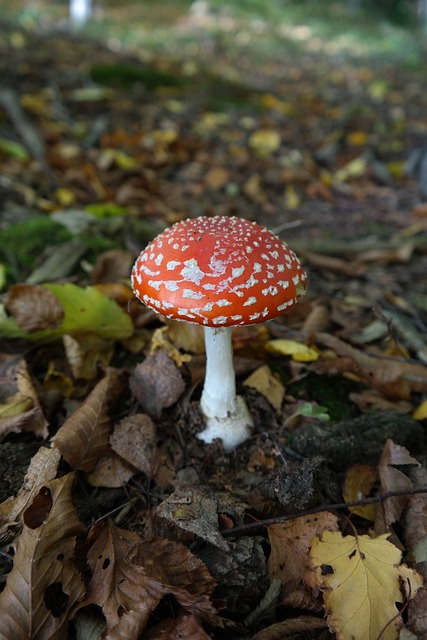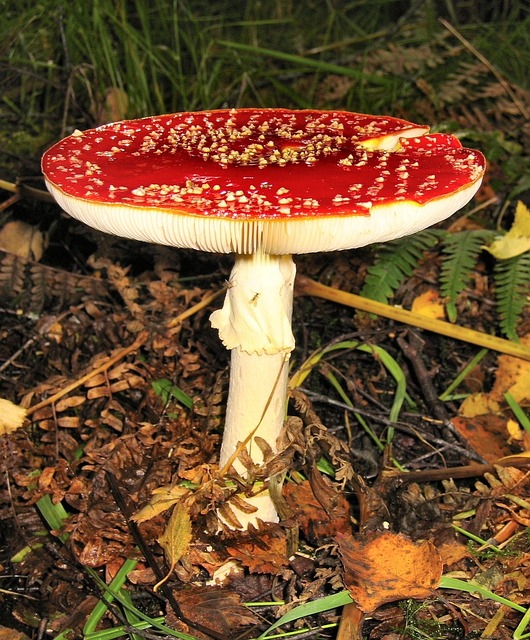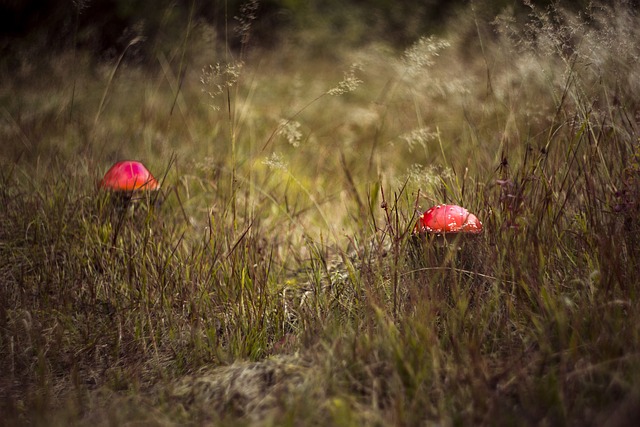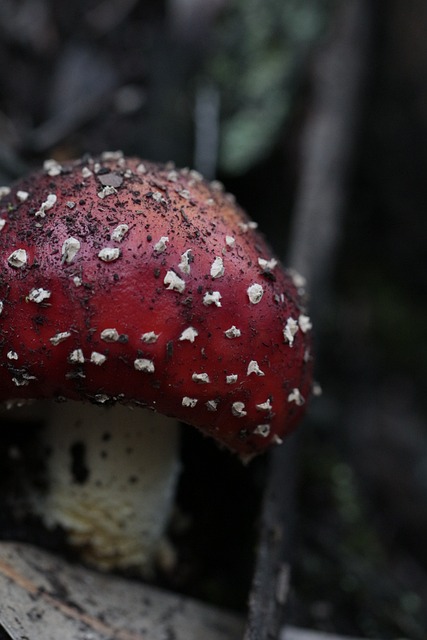The Amanita Muscaria, commonly known as fly agaric, is a versatile and edible mushroom with deep cultural roots that has recently gained attention for its potential to complement mindfulness practices. Its distinctive red-and-white cap has made it both a culinary delicacy and a subject of folklore across temperate regions. When prepared correctly, Amanita Muscaria can be a nutritious addition to the diet, offering a rich, earthy flavor that pairs well with various ingredients. Beyond its culinary appeal, this mushroom is being explored for its neurobiological effects, which may enhance meditative experiences by promoting relaxation and introspection. Scientific research is investigating Amanita Muscaria's veil and cap before cooking is essential to neutralize potential toxins, it can be dried, pickled, or incorporated into dishes like soups, stews, or paired with wild rice for a unique culinary experience. As research continues, the potential therapeutic properties of Amanita Muscaria with mindfulness practices is being examined for its contribution to mental well-being and culinary experiences featuring Amanita Muscaria is gaining interest among those exploring alternative approaches to mental clarity and focus. This article section delves into the cultural significance of this mushroom, which includes practices like meditation, deep breathing, or yoga, may be amplified by the unique properties of Amanita Muscaria when consumed responsibly under safe and controlled conditions, it can modulate neurotransmitter systems, potentially leading to a state akin to mindfulness. As research progresses in this emerging field, ethical standards and safety protocols are paramount to understand its full potential in promoting mental clarity and heightened awareness. The intersection of Amanita Muscaria's culinary and psychoactive properties with mindfulness practices offers intriguing possibilities for holistic health strategies, with the aim of providing evidence-based insights into this fascinating intersection.
Embark on a journey into the harmonious blend of culinary delights and mental well-being through the lens of Amanita Muscaria, commonly known as the fly agaric. This article unravels the nutritional prowess of this vibrant mushroom, traditionally woven into folklore and now celebrated as a mindfulness ‘superfood.’ Delve into its historical context, explore its rich nutrient profile that promotes mental clarity and focus, and learn the art of cultivation and harvesting for table enjoyment. Master the practice of mindful consumption to integrate Amanita Muscaria into your daily life, and savor its culinary versatility in the kitchen. Understand the intersection of mindfulness practices with Amanita Muscaria’s unique properties, and glimpse into the future of this edible mushroom through ongoing research and innovation in the realm of mental well-being support. Join us as we uncover how Amanita Muscaria can be a cornerstone in your path to tranquility and mindfulness.
Unveiling the Nutritional Potential of Amanita Muscaria: A Mindfulness Superfood

The Amanita Muscaria, often recognized for its iconic red and white cap, has long been a subject of fascination in both folklore and modern research. Beyond its cultural significance and historical mystique, this mushroom is gaining attention in the nutritional realm as a potential superfood, particularly within mindfulness practices. Amanita Muscaria, when properly harvested and prepared, is edible and offers a unique blend of nutrients that can complement a mindful diet. It contains significant amounts of protein, dietary fiber, riboflavin, and various B vitamins, which are crucial for maintaining cognitive function and overall mental well-being—key aspects of mindfulness. Moreover, it’s rich in antioxidants, including ergosterols, which can contribute to a healthy immune system and support the body’s natural detoxification processes. Incorporating Amanita Muscaria into a mindful eating regimen not only aligns with the principles of conscious consumption but also offers a grounding experience that enhances awareness of one’s physical and mental state. The inclusion of this mushroom in meals can be a meditative practice in itself, inviting individuals to engage more deeply with the act of nourishment and the sources of their sustenance, thereby promoting both physical health and mental clarity.
Historical Perspectives on Amanita Muscaria: From Folklore to Food

The Amanita Muscaria mushroom, with its iconic red and white cap, has long been a subject of fascination across cultures and histories. Traditionally known as “fly agaric,” this fungal species has a storied past that intertwines folklore, cultural significance, and gastronomical use. In ancient times, the Amanita Muscaria was depicted in various European folklores and fairy tales, often symbolizing mystical or hallucinogenic properties. It was believed to be a gateway to other worlds, as seen in artifacts like the Paleolithic cave paintings at Lascaux in France, where it appears alongside human figures, suggesting a ritualistic use. The mushroom’s vibrant appearance has led to its inclusion in traditional customs, where it often represented the spirit of the dead or served as a talisman against evil spirits.
Fast forward to contemporary times, and the Amanita Muscaria has found its place in culinary traditions. Despite its psychoactive compounds, which can be dangerous if ingested improperly, it is considered edible when prepared correctly. In some cultures, particularly in parts of Russia and Eastern Europe, the mushroom is a staple ingredient in certain dishes. The indigenous Sámi people of northern Scandinavia have traditionally used Amanita Muscaria in their cuisine, notably in a hot beverage that is both refreshing and stimulating. Culinary experts emphasize the importance of proper preparation to neutralize the toxic compounds, allowing for safe consumption. This careful selection and processing highlight the mushroom’s journey from a mystical entity shrouded in folklore to a respected component of regional cuisines, demonstrating the adaptability of human culture in integrating natural elements into our daily lives.
Nutritional Profile: Understanding Amanita Muscaria's Benefits for Mental Clarity and Focus

The Amanita Muscaria, commonly known as the fly agaric, is a distinctive mushroom with a rich nutritional profile that has been recognized for its potential benefits to mental clarity and focus. This edible mushroom, celebrated in folklore and art for centuries, contains several compounds that may support cognitive function. Its active ingredients, including ibotenic acid and muscimol, are psychoactive and have been traditionally used for their mind-altering effects. However, when consumed responsibly, these substances can enhance focus by modulating neurotransmitter activity, potentially leading to improved mental clarity. The Amanita Muscaria also provides a range of nutrients such as dietary fiber, riboflavin, vitamin D, and trace minerals like magnesium and potassium. These nutrients contribute to the overall well-being of the body, which is foundational for optimal mental performance. Additionally, the mushroom’s fibers aid in digestion, ensuring that the body can effectively absorb and utilize the nutrients it ingests, further supporting cognitive functions. When foraging for Amanita Muscaria, it is crucial to identify it correctly due to its hallucinogenic properties and the presence of toxic lookalikes. Proper preparation, which often involves drying and cooking, is necessary to enhance both safety and efficacy. Including Amanita Muscaria in a balanced diet may offer a unique and natural approach to promoting mental clarity and enhancing focus for those seeking alternative methods to support their mental well-being.
Cultivation and Harvesting: The Journey of Amanita Muscaria from Wild Mushroom to Table Staple

The Amanita Muscaria, commonly known as the fly agaric, is a iconic mushroom recognized for its distinctive red and white cap. This species, while renowned in folklore and fairy tales for its psychoactive properties when consumed improperly, also holds a significant place as an edible mushroom when harvested and prepared correctly. The journey of the Amanita Muscaria from a wild mushroom to a table staple involves careful cultivation and selective harvesting to ensure safety and palatability. Cultivators often employ a mycelium-based approach, where the fungal network is grown in controlled conditions to produce the mushrooms, mirroring the natural environment where these mushrooms thrive. This method not only guarantees a consistent supply but also minimizes the impact on wild populations. Once matured, the Amanita Muscaria can be harvested, typically when the veil underneath the cap is still attached and the spores are still fresh. The process continues with cleaning, preparation, and cooking, which are crucial steps to neutralize any potential toxins and reveal the mushroom’s rich, nutty flavor and meaty texture that make it a sought-after ingredient in many cuisines. Proper handling and knowledge of its culinary applications are essential for transforming this wild mushroom into an edible table staple, celebrated for its unique taste and versatility in various dishes.
Mindful Consumption: How to Incorporate Amanita Muscaria into Your Daily Routine

Amanita Muscaria, commonly known as the Fly Agaric, is a species of mushroom with a rich history of use in various cultures. Known for its distinctive red and white cap, this edible fungi can be safely incorporated into daily life to support mindfulness practices. Mindful consumption of Amanita Muscaria involves a thoughtful approach that honors both the cultural significance of the mushroom and its potential benefits for mental clarity and focus.
Incorporating Amanita Muscaria into a mindfulness routine begins with an understanding of its effects. When consumed in moderation, it can enhance one’s awareness of the present moment, fostering a deeper connection with nature and the self. To do this effectively, start by foraging for Amanita Muscaria responsibly, ensuring you have correctly identified the species and are compliant with local regulations. Once harvested, prepare the mushrooms respectfully, perhaps as part of a nourishing meal where each ingredient is appreciated for its unique contribution to the dish. As you ingest this ancient ally, pair your consumption with a mindfulness practice such as meditation or deep breathing exercises. This synergy can amplify the benefits of both the mushroom and the meditation, creating a profound and introspective experience that promotes mental well-being and self-reflection. Remember to approach this practice with reverence and an open heart, allowing Amanita Muscaria to be a natural complement to your mindfulness journey, grounding you in the present and nurturing a sense of peace and clarity.
Amanita Muscaria in the Kitchen: Preparation and Pairing for Optimal Nutrient Absorption

The Amanita Muscaria, a visually distinctive mushroom with a red-and-white cap, is not only a subject of folklore and fairy tales but also an edible delight when prepared correctly. This mushroom, native to many temperate regions, offers culinary adventurers a unique taste experience. When incorporating Amanita Muscaria into the kitchen, it’s crucial to handle it with care due to its potent properties. Proper preparation is essential to ensure the mushroom’s nutrients are optimally absorbed. Typically, the mushrooms are dried or pickled, which not only enhances their flavor but also preserves their nutrient content. Drying Amanita Muscaria concentrates its flavors, making it a robust ingredient for broths and soups, where its earthy taste can be fully appreciated. When integrating this mushroom into your culinary repertoire, consider pairing it with complementary ingredients that highlight its unique characteristics without overpowering them. For instance, its nutty and smoky notes pair well with hearty stews or as a garnish on wild rice dishes. Additionally, the mild bitterness of Amanita Muscaria can be balanced by the sweetness of caramelized onions or the tanginess of goat cheese, creating a harmonious blend of flavors that make for an unforgettable dining experience.
Amanita Muscaria’s edible properties have been recognized in various traditional diets, and its inclusion in modern cuisine is a testament to its versatility. When preparing Amanita Muscaria for consumption, it’s important to remove any remaining volval tissue beneath the cap, as this part of the mushroom can be indigestible. After thorough cleaning and preparation, the mushrooms can be added to a variety of dishes, from savory risottos to robust pasta sauces. The key to enjoying Amanita Muscaria is to complement its distinct flavor with ingredients that enhance its culinary potential. By thoughtfully selecting pairings such as thyme, garlic, and creamy sauces, one can elevate this mushroom’s role in any dish, ensuring a delightful gastronomic experience while making the most of its nutritional benefits.
The Science of Mindfulness and Its Synergy with Amanita Muscaria's Properties

The practice of mindfulness, characterized by a focus on the present moment without judgment, has garnered significant attention in both clinical and holistic health realms for its efficacy in reducing stress, improving emotional regulation, and enhancing overall mental well-being. The science of mindfulness is grounded in neurobiological changes that occur with consistent practice, particularly within brain regions associated with attention, cognitive flexibility, and emotion regulation. This is where the synergy with Amanita Muscaria, commonly known as the ‘Fly Agaric’, comes into play. As an edible mushroom with psychoactive properties, Amanita Muscaria has been used historically in various cultural contexts to elicit a range of experiences from spiritual insight to euphoria. Its active compounds, including muscimol and ibotenic acid, have been shown to influence neurotransmitter systems in the brain, potentially mimicking some aspects of the mindfulness state by promoting relaxation, introspection, and altered sensory perception. The intersection of Amanita Muscaria’s properties with mindfulness practice could offer a unique pathway for individuals seeking to deepen their meditative experiences and achieve greater mental clarity. However, it is crucial to approach this synergy with caution and within a context that emphasizes safety, legality, and responsible use, given the potent effects of the mushroom. Research into the combination of Amanita Muscaria and mindfulness practices is an emerging field, promising potential for expanded understanding and application of both in holistic mental health approaches.
Cultivating Mindfulness through Amanita Muscaria: Practices to Enhance Mental Well-being

Incorporating Amanita Muscaria, commonly known as the fly agaric, into mindfulness practices can be a unique approach to enhancing mental well-being. This distinctive mushroom, recognized for its vibrant red and white cap, has historical significance in various cultures for its psychoactive properties. When consumed responsibly, Amanita Muscaria edible can serve as a catalyst for deep introspection and heightened awareness. Practitioners of mindfulness who explore this avenue may find that it facilitates a greater connection with their environment and inner self, promoting a state of presence and serenity. It’s important to approach the use of Amanita Muscaria with caution and respect for its potency; when integrated into mindfulness rituals, it can aid in breaking down barriers to mental clarity and emotional balance.
To safely and effectively cultivate mindfulness through Amanita Muscaria, it is essential to engage in practices that complement its effects. This may include setting a clear intention for the experience, ensuring a safe and comfortable environment, and perhaps combining it with other mindfulness techniques such as meditation or yoga. The goal is to harness the mushroom’s unique properties to enhance one’s ability to stay grounded and fully engaged in the present moment. It’s crucial to remember that mindfulness practices are most beneficial when they are consistent and tailored to the individual, with or without the inclusion of Amanita Muscaria. Whether one chooses to include this mushroom in their mindfulness journey or not, the principles of mindfulness remain centered on cultivating a non-judgmental awareness of the present moment, leading to improved mental health and overall well-being.
Exploring the Future of Amanita Muscaria: Research and Innovation in Mindfulness Support

The Amanita Muscaria, commonly known as the fly agaric, has long been a subject of fascination due to its distinctive red and white cap that adorns forests across the globe. Traditionally recognized for its psychoactive properties, recent research is focusing on the potential of this edible mushroom in supporting mindfulness practices. Advances in neuroscience and psychology are shedding light on how Amanita Muscaria can modulate consciousness, offering a unique avenue for individuals seeking heightened awareness and mental clarity. Scientists are exploring the ways in which this mushroom might be used to enhance meditation and mindfulness exercises by inducing a state of introspective focus. Clinical trials and studies on the effects of Amanita Muscaria consumption under controlled conditions are underway, with the aim of understanding its potential as a complementary tool for mental health and well-being. The future of Amanita Muscaria in mindfulness support is poised at the intersection of research and innovation, where careful examination of its effects on cognitive processes could lead to new therapeutic applications and holistic health practices. As this field of study progresses, it is imperative that researchers continue to approach the subject with a scientific lens, ensuring ethical considerations and safety guidelines are followed to fully realize the potential benefits of Amanita Muscaria for those interested in mindfulness support.
